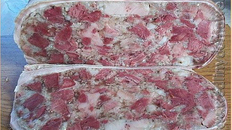Meats and Sausages
Farmer's Head Cheese (Salceson wiejski)
Countryside Head Cheese is one of the easiest head cheeses to make. You can substitute pork heads with picnics. Blood may be omitted.
| Meats | Metric | US |
|---|---|---|
| pork heads (with bones) | 800 g | 1.76 lb. |
| pork legs (with bones) | 180 g | 0.40 lb. |
| blood | 20 g | 0.04 lb. |
Ingredients per 1000g (1 kg) of meat
| salt | 18 g | 3 tsp. |
| pepper | 2.0 g | 1 tsp. |
| allspice | 2.0 g | 1 tsp. |
Instructions
- Wash pork heads and legs in cold running water.
- Poach heads and legs in separate containers at 185º F, (85º C) until meat can be removed from the bone (try not to cook the meat). Save some of the left over stock liquid for later. Spread all cuts on a flat surface to cool.
- Cut head meat into 1/2” (12 mm) cubes. Grind leg meat with 3/16” (3 mm) plate.
- Mix all meats with salt, spices, blood and add some of the saved stock.
- Stuff mixture not too tight into hog stomachs or beef bungs about 12” (30 cm) long, 8” (20 cm ) wide and 3” (8 cm) thick. Saw the ends with butchers twine.
- Cook in water at 180º F, (82º C) for about 90-120 min (depends on a size) until internal temperature of 154º-158º F, (68º-70º C) is obtained. If stuffed bungs swim up to the surface prick them with a needle to release air.
- Place head cheeses on a flat surface to cool them down and let more moisture evaporate. Then cool them down to below 42º F, (6º C), place in refrigerator and put some weight on top of it (determines the shape and the thickness of the finished product).
- After cooling clean head cheese of any fat and aspic that accumulated on the surface, even them out and cut off excess twine.
- Store in refrigerator.


















